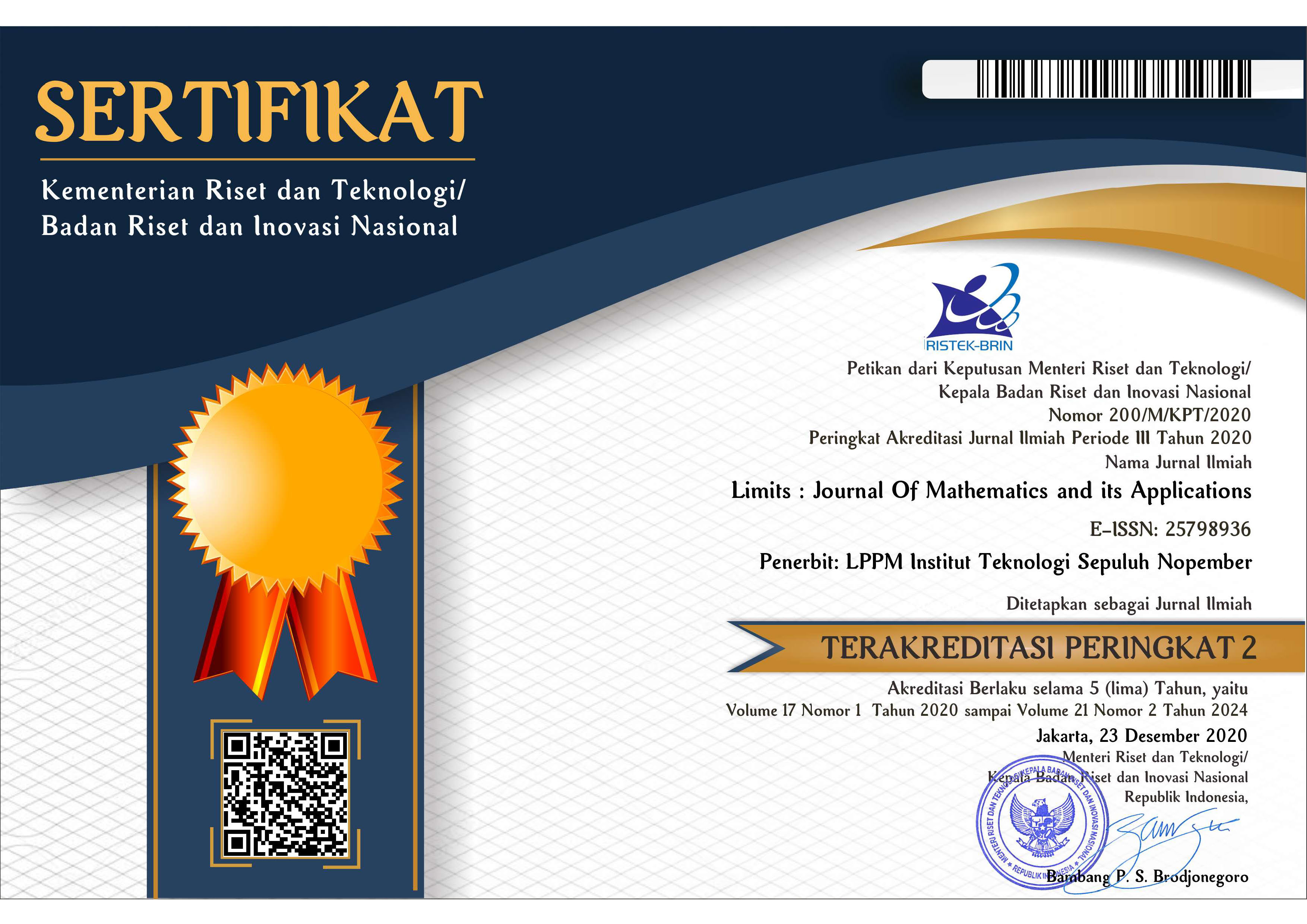Analisis Model Epidemi SVEIR Pada Penyebaran Penyakit Campak dengan Tiga Kali Vaksinasi
Abstract
In 2021, there will be 9 million cases of measles worldwide. Twenty-two countries have large numbers of measles infections. The Ministry of Health of the Republic of Indonesia or Ministry of Health recorded that there were more than 3,341 cases of measles spread across 223 districts/cities in 31 provinces. The control of measles cases carried out by the Indonesian government has been through vaccination since 2000. The first vaccine is given to children aged nine months, the second vaccine is given to children aged 18 months, and the third dose is in grades 1-6 of elementary school (SD). This research uses the SVEIR mathematical model for the spread of measles with adjustments to government efforts and recommendations from the Indonesian Pediatrician Association (IDAI) to prevent an increase in the spread of measles through preventative vaccination. In this SVEIR model, there are seven classes, namely Susceptible (S), first dose vaccination (V1), second dose vaccination (V2), third dose vaccination (V3), Exposed (E), Infected (I), and Recovered (R). This research aims to analyze the SVEIR model on the spread of measles with three vaccinations, the stability of the equilibrium point, and determine the effect of vaccination in controlling measles. The analysis results show that the endemic equilibrium point is asymptotically unstable, and the non-endemic equilibrium point is asymptotically stable with R_0=0.0736829 <1. This indicates that measles will disappear on the 260th day or around 8.5 months after implementing the vaccination program.
Keywords
Full Text:
PDFReferences
Ferren, Horvat, and Mathieu, “Measles Encephalitis: Towards New Therapeutics,” Viruses, vol. 11, no. 11, p. 1017, Nov. 2019, doi: 10.3390/v11111017.
Kementrian Kesehatan Republik Indonesia, Profil Kesehatan Indonesia 2022. Kementrian Kesehatan Republik Indonesia, 2023.
D. Aldila and D. Asrianti, “A deterministic model of measles with imperfect vaccination and quarantine intervention,” J. Phys.: Conf. Ser., vol. 1218, no. 1, p. 012044, May 2019, doi: 10.1088/1742-6596/1218/1/012044.
S. E. Lekana-Douki et al., “Epidemiology and molecular characterization of the re-emerging measles virus among children and adults in the Haut-Ogooue, Gabon,” BMC Infect Dis, vol. 19, no. 1, p. 90, Dec. 2019, doi: 10.1186/s12879-019-3731-y.
Kementerian Kesehatan Republik Indonesia, “Waspada, Campak jadi Komplikasi Sebabkan Penyakit Berat.” Kemkes.go.id, 2023. Accessed: Feb. 18, 2024. [Online]. Available: https://sehatnegeriku.kemkes.go.id/baca/rilis- media/20230120/1642247/waspada-campak-jadi-komplikasi-sebabkan- penyakit-berat
C. I. Paules, H. D. Marston, and A. S. Fauci, “Measles in 2019 — Going Backward,” N Engl J Med, vol. 380, no. 23, pp. 2185–2187, Jun. 2019, doi: 10.1056/NEJMp1905099.
A. A. Minta et al., “Progress Toward Measles Elimination — Worldwide, 2000–2022,” MMWR Morb. Mortal. Wkly. Rep., vol. 72, no. 46, pp. 1262–1268, Nov. 2023, doi: 10.15585/mmwr.mm7246a3.
A. A. Minta et al., “Progress Toward Regional Measles Elimination — Worldwide, 2000–202,” vol. 71, no. 47, 2022.
WHO, “Nearly 40 Million Children Are Dangerously Susceptible To Growing Measles Threat.” who.int, 2022. Accessed: Feb. 18, 2024. [Online]. Available: https://www.who.int/news/item/23-11-2022-nearly-40-million-children-are-dangerously-susceptible-to-growing-measles-threat
DInas Kesehatan Provinsi DKI Jakarta, Profil Kesehatan DKI Jakarta Tahun 2017. Dinas Kesehatan, 2018.
R. Magodi, E. J. Mmbaga, J. Massaga, D. Lyimo, A. Mphuru, and A. Abade, “Factors associated with non-uptake of measles-rubella vaccine second dose among children under five years in Mtwara district council, Tanzania, 2017,” Pan Afr Med J, vol. 33, 2019, doi: 10.11604/pamj.2019.33.67.17055.
Ikatan Dokter Anak Indonesia, “Imunisasi Campak-Rubella (MR).” idai.or.id, 2017. Accessed: Feb. 18, 2024. [Online]. Available: https://www.idai.or.id/artikel/klinik/imunisasi/imunisasi-campak-rubella-mr
W. O. Kermack and A. G. McKendrick, “Contributions to the mathematical theory of epidemics—I,” Bulletin of Mathematical Biology, vol. 53, no. 1, pp. 33–55, Jan. 1991, doi: 10.1016/S0092-8240(05)80040-0.
J. Juhari, O. Karinina, A. Aziz, and E. Alisah, “Global Stability Analysis of Susceptible, Infected, Recovered (S, I, R) Model Measles Vaccination Based on Age,” InPrime:Ind.Jour.Pure.Applied.Math, vol. 5, no. 2, pp. 144–160, Nov. 2023, doi: 10.15408/inprime.v5i2.32318.
W. D. Sihotang, C. C. Simbolon, J. Hartiny, D. Tindaon, and L. P. Sinaga, “Analisis Kestabilan Model SEIR Penyebaran Penyakit Campak dengan Pengaruh Imunisasi dan Vaksin MR,” JMSK, vol. 16, no. 1, p. 107, Jun. 2019, doi: 10.20956/jmsk.v16i1.6594.
P. Widyaningsih, L. F. Aminni, and D. R. S. Saputro, “Measles free prediction and control strategy to achieve measles elimination target in Indonesia based on SVEIR model,” presented at the INTERNATIONAL CONFERENCE OF MATHEMATICS AND MATHEMATICS EDUCATION (I-CMME) 2021, Surakarta, Indonesia, 2022, p. 030008. doi: 10.1063/5.0116992.
O. J. Peter, H. S. Panigoro, M. A. Ibrahim, O. M. Otunuga, T. A. Ayoola, and A. O. Oladapo, “Analysis and dynamics of measles with control strategies: a mathematical modeling approach,” Int. J. Dynam. Control, vol. 11, no. 5, pp. 2538–2552, Oct. 2023, doi: 10.1007/s40435-022-01105-1.
Badan Pusat Statistik, STATISTIK INDONESIA 2022. Online: Badan Pusat Statistik, 2022. Accessed: Feb. 10, 2024. [Online]. Available: https://www.bps.go.id/id/publication/2022/02/25/0a2afea4fab72a5d052cb315/statistik-indonesia-2022.html
S. Khanal et al., “Morbidity and Mortality Weekly Report (MMWR),” Centers for Disease Control and Prevention, Jul. 21, 2017. Accessed: Mar. 12, 2023. [Online]. Available: https://www.cdc.gov/mmwr/volumes/66/wr/mm6628a3.htm
D. Aldila and D. Asrianti, “A deterministic model of measles with imperfect vaccination and quarantine intervention,” J. Phys.: Conf. Ser., vol. 1218, no. 1, p. 012044, May 2019, doi: 10.1088/1742-6596/1218/1/012044.
P. Rodríguez-Zamorano, J. Otero Otero, A. Pérez González, L. E. Moro Rodríguez, and F. Marco, “[Translated article] Primary total hip arthroplasty in patients with sequelae of poliomyelitis,” Revista Española de Cirugía Ortopédica y Traumatología, vol. 67, no. 5, pp. T401–T410, Sep. 2023, doi: 10.1016/j.recot.2023.06.007.
L. Wang, Z. Liu, C. Guo, Y. Li, and X. Zhang, “New global dynamical results and application of several SVEIS epidemic models with temporary immunity,” Applied Mathematics and Computation, vol. 390, p. 125648, Feb. 2021, doi: 10.1016/j.amc.2020.125648.
H. Anton and C. Rorres, Elementary Linear Algebra, 11th ed. Canada, 2013.
R. Resmawan, A. R. Nuha, and L. Yahya, “Analisis Dinamik Model Transmisi COVID-19 dengan Melibatkan Intervensi Karantina,” Jambura J. Math, vol. 3, no. 1, pp. 66–79, Jan. 2021, doi: 10.34312/jjom.v3i1.8699.
DOI: http://dx.doi.org/10.12962%2Flimits.v21i2.20710
Refbacks
- There are currently no refbacks.
Jumlah Kunjungan:

Limits: Journal Mathematics and its Aplications by Pusat Publikasi Ilmiah LPPM Institut Teknologi Sepuluh Nopember is licensed under a Creative Commons Attribution-ShareAlike 4.0 International License.
Based on a work at https://iptek.its.ac.id/index.php/limits.






